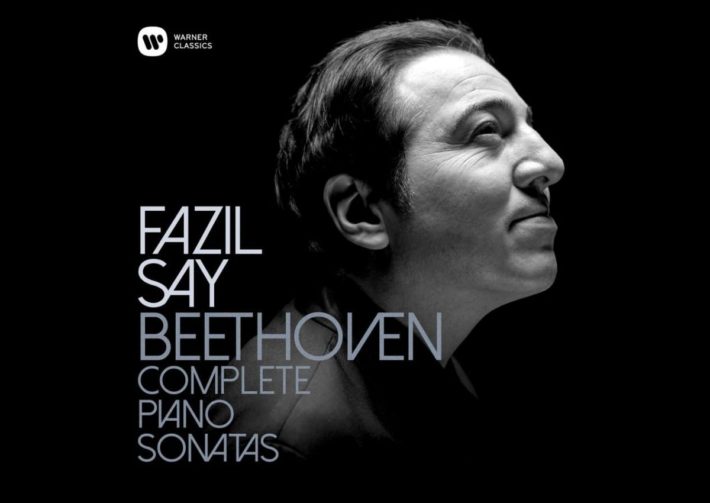Part of the Beethoven 250 birth year celebrations, pianist Fazil Say has extended his Beethoven discography with the complete set of Piano Sonatas. This will undoubtedly be compared to Igor Levit’s impressive cycle for Sony, reviewed on these pages a few months back. If the Levit set was marked by impressive consistency of approach and tone, this set is marked by musical contrasts.
Those familiar with Fazil Say’s pianism in concerts and on discs won’t be surprised; He is often compared to Glenn Gould in his sometimes unconventional interpretations, but one must admit that the pianist’s choices here are a cause for a debate, rather than outrage. He is taking particular pleasure of following Beethoven’s instructions to a T, and so many phrases contain an almost comical effect just because of Say’s literal obedience to the score. Listen, for example, to Op. 27 No. 1 first movement. The opening phrase is executed with the first chords played Staccato, which may feel as interfering with the movement’s singing quality, yet reading the score shows that this is what Beethoven wrote. The question here, as in other places in this cycle, is where do pianists need to employ some common sense? Haydn, Beethoven and Schubert, still developing some of the notation system we now today, were all using Staccato markings on single notes in long phrases. Did they always want them to be played so short, or was this a sort of emphasis to remind the pianist to retain clarity?
On the other side of the spectrum, Say’s slow movements are quite free in their approach, with left-hand chords played broken and bass notes played a split second before the bar – a habit reminiscent of 19th century and early 20th-century pianism. Some will find this anachronistic, but I for one found it utterly enchanting. Indeed, the slow movements in the cycle, especially in the early Sonatas, show superb pianism, though they don’t always sit comfortably with other movements in the same Sonata.
Related Classical Music Reviews
- Review: Beethoven – Complete Piano Sonatas – Igor Levit
- Review: Beethoven – Complete Symphonies – Vienna Philharmonic Orchestra – Nelsons
- Review: Ivo Pogorelich Plays Beethoven and Rachmaninov (2019)
Another special feature of Say’s interpretations is the tempo choices of the Finales. Rather surprisingly (but not completely different from Andras Schiff’s cycle), Tempi are measured and articulated with special care, most notable in the pieces before the three Op. 31 Sonatas. And so the famous Finale of Op. 13 (“Pathétique”) is given a charming rather than hectic overview, and the Finale of Op. 27 No. 2 (“Moonlight”) is impressive in its clarity and multilayered approach.
Say’s interpretations didn’t change noticeably from his previous Beethoven recording, all successful; He already recorded “The Tempest”, “Waldstein” “Appassionata” and Op. 111 before – though re-listening to the early attempts shows that Say rethought some elements and in general is more reserved in his dynamic outbursts and tempo choices. The “Appassionata”, already impressive in Say’s previous attempt (Mirare, 2005), is even better communicated here, and is one of the biggest successes of the cycle.
Levit kept his wonderful account of the last five Sonatas from his recording debut for Sony a few years back. Say’s performances all come from the same recording sessions as the rest. There is a noticeable change in atmosphere in these endlessly fascinating works, not for the piano writing alone but for Say’s handling of the music. It’s obvious the pianist sees the late piano music as forward-looking pieces of music, but even more so, as unique creations like no others. There is a special inwardness and resolve in his performances here, even in vastly dramatic works such as the Hammerklavier (Op. 106). In this work, some may be surprised by the relatively slow tempo of the first movement, far from the indicated, almost unplayable, tempo instructions Beethoven gave but not far off from famous performances from the past like Arrau, Kempff and others. It works as complete performance, giving the pianist more space to examine this work’s intricate contrapuntal writing and to give more weight to the slow movement, which is played completely free, breaking hands and using the pedal to its full, modern-day potential. I found Say’s approach to this Sonata refreshing, though I could live without the occasionally added bass notes in the left hand, unavailable to pianists of Beethoven’s time.
Say’s handling of the final three Sonatas (Op. 109-111) is nothing but superb, bringing an engaging and intriguing journey to an end. Say’s previous performance of Op. 111 was one of his altogether best recordings, and here there is an added spirituality and clear-headedness less evident than before.
Throughout, Say’s piano timbre is bright, with a hint of brilliance in the upper register and a clear, resonating bass that never overwhelms. Superb recording quality too, though like Gould, Say’s singing-along is noticeable, especially in the slow movements. In sum, this is a cycle more surprising and readily controversial than others in recent years, one to be purchased as an alternative to established cycles (some listen below), and to return to with sustained interest.

Beethoven – Complete Piano Sonatas (1-32)
Fazil Say – Piano
Warner Classics, 9 CDs, 9029538024
Albums Mentioned In This Review
Read more classical music reviews or visit The Classic Review Amazon store
Follow Us and Comment:
Get our periodic classical music newsletter with our recent reviews, news and beginners guides.
We respect your privacy.








